The Royal Navy is exploring the use of nuclear power for its surface ships, with the Ministry of Defence (MOD) issuing a Request for Information (RFI) seeking insights from the defence industry.
The RFI signals the Royal Navy’s interest in understanding how Generation 4 nuclear reactors might be integrated into its fleet.
The MOD has emphasised that this RFI is not a tender but a way to gather information from industry leaders. The request is being conducted in line with the Defence and Security Industrial Strategy (DSIS), which seeks to foster productive relationships with defence and security industries.
The MOD states that any future procurement will comply with relevant legislation, but it clarifies, “No more further discussions with industry are planned at this stage. In the event of any future procurement activity, it would be advertised in line with public procurement regulations on the Defence Sourcing Portal and Contracts Finder.”
The Royal Navy is specifically looking into the possibility of using Generation 4 nuclear technologies, including both larger nuclear reactors and micro modular reactors, for powering large surface ships.
The RFI highlights the need for detailed technical information, stating, “The Royal Navy (RN) is seeking information regarding integrating Generation-4 nuclear technologies for surface ship employment. Exploring scopes for alternative energy paradigms, the Royal Navy is gathering information on energy solutions for powering large surface ships.”
Generation 4 nuclear technologies are the next generation of advanced reactors designed to improve safety, efficiency, and sustainability compared to older models. These reactors focus on reducing nuclear waste, using fuel more efficiently, and incorporating passive safety systems to prevent accidents.
A key feature is the development of smaller, modular designs like Small Modular Reactors (SMRs), which are more flexible and can be deployed in a wider range of settings, including for naval applications. These reactors also aim to reduce the environmental impact of nuclear power while maintaining high operational performance.
The RFI goes on to explain the objective of the information-gathering exercise: “The primary objective is to gather detailed information on GEN-4 nuclear-reactor designs, their feasibility for large surface ships (including support vessels and surface combatants), and the potential benefits and challenges associated with their use.”
The MOD is particularly interested in understanding the technical feasibility of integrating nuclear power into existing and future naval vessels, as well as the operational implications this might have.
In addition to technical feasibility, the RFI requests information on several key areas. These include detailed technical specifications of Generation 4 reactors suitable for maritime use, their power output, and safety protocols.
The MOD asks for “Detailed descriptions of Generation-4 nuclear reactor designs suitable for maritime applications,” as well as information on “power output, efficiency, and operational parameters.” Safety features are also a primary concern, with the document seeking information on “safety features and protocols inherent to Generation 4 reactors.”
Beyond technical details, the MOD is also exploring how these reactors could be integrated into ship designs. The RFI asks for responses addressing “requirements for integrating Generation-4 reactors into the design and construction of large surface ships.” This includes how modifications to existing ship designs would be required to accommodate nuclear power systems, as well as the research questions that need to be addressed to make these technologies viable for naval use.
The MOD is also interested in understanding the broader implications for the fleet, such as crewing, training, and maintenance, asking for information on “implications for wider Defence Lines of Development (crewing, training, maintenance, supporting infrastructure, and other such effects).”
The RFI also touches on environmental and regulatory considerations. The MOD seeks industry input on “lifecycle-sustainability assessments and mitigation strategies for nuclear-powered ships,” as well as on the “key regulatory frameworks governing the use of nuclear power in maritime settings.”
This demonstrates the MOD’s awareness of the need for thorough environmental and regulatory planning as it considers the potential introduction of nuclear-powered ships into the Royal Navy.
This information-gathering exercise could be followed by further engagement with the industry. The RFI states, “Following viability of returns, the Royal Navy may hold a forum to explore key details from selected responses and/or an action learning event.” This would provide the MOD with an opportunity to further explore the practicalities and challenges of using nuclear power in its fleet, as well as gain insights from industry experts.
The deadline for responses to this RFI is October 8, 2024, at 22:59.
While no decisions have been made regarding the procurement of nuclear technologies at this stage, the MOD’s request for detailed technical information indicates that the Royal Navy is seriously considering how nuclear power could fit into its future fleet. As the RFI explains, this initiative is part of the Royal Navy’s broader effort to gather information that will inform its future strategic decisions.
Nuclear at sea?
Nuclear-powered warships have been in service with several navies around the world for decades, although they are more commonly associated with submarines. The United States Navy operates a number of nuclear-powered aircraft carriers, including the well-known Nimitz and Gerald R. Ford-class ships.
These carriers can remain at sea for extended periods without needing to refuel, thanks to their nuclear reactors, which provide them with almost unlimited range. Similarly, France’s Charles de Gaulle aircraft carrier has been nuclear-powered since it entered service in 2001.
While most people think of nuclear-powered submarines when it comes to naval nuclear propulsion, it’s not unusual for surface ships to run on nuclear power in some of the world’s major fleets. Submarines, however, have been the primary beneficiaries of this technology. Their ability to stay submerged for long periods without surfacing to refuel gives them a significant operational advantage. The Royal Navy, for instance, operates an entirely nuclear-powered submarine fleet, including its Vanguard-class submarines, which carry the UK’s nuclear deterrent, and the Astute-class attack submarines.
Despite this, the UK has never operated a nuclear-powered surface ship. All of the Royal Navy’s surface fleet, including its aircraft carriers, destroyers, and frigates, are conventionally powered. The RFI issued by the Ministry of Defence represents a potential shift in this approach as the Royal Navy considers the possibility of integrating Generation 4 nuclear reactors into large surface ships, such as support vessels and warships.
Through this RFI, the Royal Navy is seeking input from the defence industry to explore how nuclear power—used so effectively in submarines—could enhance the capabilities of its surface fleet. The move could allow ships to operate for longer periods, reduce their reliance on fuel supplies, and potentially transform how the Royal Navy operates at sea.



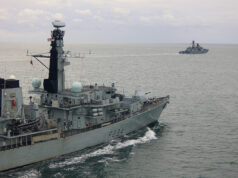
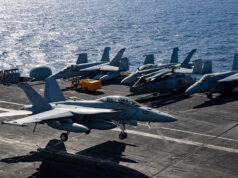

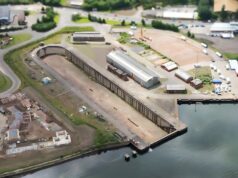
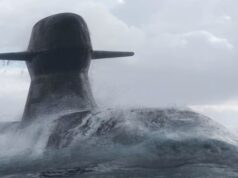

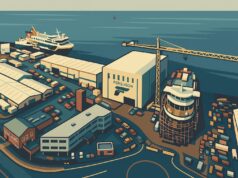
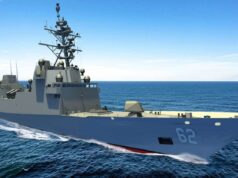
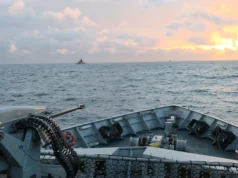


Nuclear powered T83 Cruiser?
Wouldn’t that be fun!
I imagine this is related to the Rolls Royce work on SMRs and micro reactors.
The micro ones claim to be able to produce between 1 and 10 MW and fit inside a TEU.
I don’t know how noisy they would be but if they weren’t too loud I can imagine them replacing the DGs, for example on the T26 in quiet mode.
RR pr? The small nuclear reactors will be safe and low maintenance and hopefully so, but until that day not really needed on ships for time being.
Certainly would solve the power problems associated with non ballistic weaponry and sensors as well as the propulsion potential. If the 4th Gen Micros are Molten Salt Reactors then that seriously improves their safety factors, lose power and they theoretically automatically close down rather than potentially become unstable as traditional reactors do. Somewhat vital in a warship one might think.
Still a lot of work to be done with micro reactors mind, despite all the hype about cost, time to build and running costs so far none of those promises with the few that have, or are in the process of being built have so far achieved. Early days however and there is no one flavour but within a decade we will be far better placed to judge and even hopefully real time benefitting from.
Conventional reactors are PWR types. The W stands for water, which is there coolant. What do you think happens when a PWR sinks….. in water? (This has happened a few times)
What do you think happens when molten salt hits water?
Also look up negative reactivity feedback?
Dont really have much faith that they’ve got anywhere with that ‘micro-reactor’, there hasn’t (to my knowledge) been MoD or other external funding for it, and they havent announced much about it.
PWR3 is widely believed to be based off the U.S S9G design, and the manufacturing capacity is barely kept alive to support the submarine program. They are/were supposed to ramp this facility up, even before AUKUS, but are woefully behind.
I get where they’re coming from, if you make 8 submarines with a 40 year lifespan, your factory can either build 1 a year and then go bust for 32 years, or you can output 1 every 5 years, but they’ve let the industry decline a bit too much.
T38? twenty years away and longer still if the Clyde gets the job to build them cruiser? We’ve already got them only we call them the type 26 Frigate. ditto destroyers.
which simply needs reconfiguration to carry out the roles
Given the struggles the Australians are having, there’s no “simply needs reconfiguration”. The Hunters are demonstrating that, despite being a big, capable ship, the T26 isn’t big enough to pack in a large BMD radar and the armament to match.
We’ve got a decade before construction begins on T83, it’s not reasonable to expect a frigate design from the 2010s to do high-end air defence work into the 2060s
“T26 is not big enough”. So Australia made it longer & wider. BAE are already offering 48/64/96/128 mk41 versions. 2010 design & high end air defence? USN AB destroyer ring a bell? USN would love for it to be a 2010 design. And they are still building them even though they know they need a new design.
Could you build a better destroyer? Sure. Show me the money. No money? Bit of a rock & a hard place then.
The heavier armaments all come at the expense of some of the T26’s key features; the mission bay, ASW capability, even the main guns. Given that we’re after a multirole destroyer and not an arsenal ship, it’s a questionable option at best.
The USN tried to move away from the Burke design, fucked it up beyond recognition, and then resumed Burke building to cover the gap while they scrambled to design a surface combatant that actually works. They’re not building old destroyers out of choice, and they’ve already admitted the design is maxed out. It’s a very different scenario to where the RN finds itself.
The bulk of the cost of T83 will inevitably be the combat system; whether it’s an evolution of Sea Viper or a US Aegis successor, it doesn’t exist yet. Given that there’s no time pressure, it makes a hell of a lot more sense to develop the combat system and then design a ship that can support it, instead of potentially trying to cram it into what would be a rather small destroyer by 2040 standards.
Yeah i think that would be a good place to start.
Blimey. That’s a first if it ever comes to fruition.
No visiting NZ then. Though, the RN might not venture there again with this government by the noises in the wind.
Hi Daniele, yes that’s what Iwas thinking. Although I suspect that many nations are pro nuclear power and associated infrastructure, so may not be a major issue for the near future. Especially as there will be a shift to more sustainable fuel including nuclear.
Cheers
George
ha ha to true- makes you laugh (or cry)!. Mention nuclear here in NZ and they’ll burn you at the stake for heresy.😚
The USN did operate other nuclear powered cruisers decades ago, but doesn’t any more because the overall lifecycle cost is much higher than for conventionally powered equivalents, even before reactor decommissioning is taken into account.I suspect MOD is trying to work out if the modular reactor concept is a real game-changer in cost terms, in which case it might be useful. Given the practical consequences of a reactor being destroyed by enemy action the implication would also be that a nuclear-powered ship is not to be put in harm’s way. If it was going to be used as a mothership for unmanned systems then one of the advantages of a nuclear reactor is that it can be used to charge batteries or generate hydrogen fuel by electrolysis. Obviously food and aviation fuel remain limiting factors on endurance.
I reckon there are two drivers here:
Wasn’t there a concern over EMALs in a conventional powered carrier (ie weren’t sure if they could generate enough power reliably) – or have I imagined that?
Don’t know the specifics but yes it would present issues with all the power generally new ships require especially one like a carrier considering future growth considerations. Don’t know whether the nuclear option for the carriers at concept stage were connected to the potential EMALs option or were considered separately, but I suspect there was some overlap in their consideration amongst planners even though one doesn’t exclude the other. I do wonder what non nuclear set up they were proposing for a non nuclear EMALs system back then when the latter was very much in its infancy or were they still considering a more traditional system at the time. Don’t think it ever got that far that such issues were truly confronted.
The EMALs needs to generate a lot of power for a very short period of time- the carriers were designed with it in mind as an option so I don’t think it’s an issue (other engineering problems did surface thought). For smaller vessels futuristic things like laser DEW or railguns the power draw is definitely a challenge at the moment.
I don’t understand the logic that says nuclear-powered ships shouldn’t be put in harm’s way.
What are the practical consequences of a reactor being destroyed by enemy action? Wouldn’t that depend of which brand of GEN 4 we are talking about? A few Soviet nuclear reactors sit on the bottom of the sea, mostly just cheap “disposal”, also through loss of the boats they were sat in. We know of at least 17 that are in the shallows of the Abrosimov Gulf near Murmansk (maybe 30m down). There are other known dump sites in Sivolky Gulf, Stepovov Gulf, and the Kara Sea. The Americans have also lost a couple of nuclear subs and have admitted to sea-dumping one reactor.
Aren’t nuclear powered subs at hazard of enemy action. Wouldn’t we try to sink theirs?
UK and US Subs use highly enriched urainium for the core. Lots of power and a long life is the result. The new cores power output will outlast the hull
French use low enriched so need to refuel a lot more. More dockings and longer out of service.
SMRs should be easier to use for specific applications. The problem with nuclear is the people to operate them. Nuclear watchkeepers get paid a fortune to stay in the RN. If they dont get the pay the civilian world poaches them with rockstar wages and perks…
That was a thought that crossed my mind considering problems with retainment and recruitment.
I suspect the MOD’s interest involves trying to work out if there’s any chance that the new reactors will mitigate that operating cost. I rather doubt it.
Push comes to shove, government can override anything if they want too (especially if the crown is onside). As HM is ex RN, I think he understands what a reactor is. Chernobyl is stretching it in regards UK SSN navy reactors, but the memory remains. Ex navy nuclear engineers (or anyone else) can suddenly find themselves reactivated regardless of civilian arrangements.
No-one is terribly happy about those Soviet boats rusting on the seabed and eventually the reactor cores are going to disintegrate. We would expect to lose SSNs in WWIII (and would then be the least of our problems), but they aren’t really in much danger in the low-end conflicts that we more frequently engage in. They are inherently more survivable than surface vessels because they’re hard to detect and engage.
Yes interesting that the US is committed to using a single fuel type for as many included platforms operating on its America LHA class ships so as to improve their endurance and simplicity in re-supplying. I agree modular reactors would have to meet their promise in full while proving radically safer to be seriously considered I suspect.
I wonder if the true worth might be if they do prove to be as flexible, compact, safe and self contained as promised that they could indeed be incorporated in ‘shipping containers’ or equivalent and potentially used as required in larger ships in their flexible mission bay. From images I have seen the design incorporates two containers the reactor modal and the control module so it would probably only be relevant to a large destroyer and perhaps more likely larger support ships in that form rather than built in.
So what happens when AShM hits said shipping container? NSM is around 120kg warhead & it’s at the low end. Harpoon 220kg approx, LRSM over 450kg. All theory aside, I don’t want to be anywhere near one of these if things go pear shaped.
like idea it’s more than a propulsion issue there’s ec jsss too look at the
cost of getting rid of the old SSNs at rosyth and devonport
One of the first things I asked when I did a deployment to it was “What are they doing with all these old subs”. I was told that they were still looking for a solution. The new SSN, SSBN’s will result in another 10 tired up alongside. The ‘dump’ isn’t getting smaller. There were 7 when I did my stint up there and and another 10 in Devonport.
If you can make hydrogen you can make aviation fuel from the hydrogen and carbon dioxide. It’s already been done on a small scale in Orkney and used by the RAF.
Quickly, in bulk, at sea? You could of course run an aircraft on liquid hydrogen if you could overcome those engineering challenges.
Earlier this year I discussed a nuclear-powered Tide class with someone from BMT (his idea not mine). By generating synthetic fuel on board, many of the advantages, such as zero carbon extend to the entire fleet, with the minimum amount of change. Visits to New Zealand are uninterupted.
I also rather like the idea of having nuclear-created synthetic fuel from offshore refuelling/generation centres. Fewer problems with planning permission and costly obsolete regulations for a start.
Not too sure if NZ will agree. RAN SSN’s? Maybe (eventually).
Nuclear Powered Warships? I do understand the thinking of getting off fossil fuels etc, and the need for greater power generation for new weaponry. But if this was our chosen route I would of also thought you’d have a much higher reliance on replen at sea for solids stores/ammunition etc. For example due to the amount of ports that won’t accept Nuclear (one of the considerations of the QE class IIRC). How are the RFA doing in that regard recently?
Others have also mentioned the people problem as well. There’s also the disposal issue though i doubt anyone in power will think about that seriously until the first decommissioning’s are rapidly approaching. Just look at how many old subs are still waiting.
On a side note, if there was any sign of this becoming a serious possibility it could be a good time to buy some RR shares 😉
Literally just came to me reading your contribution, if as claimed MSR reactors on which these modular reactors could be based, do have a failsafe nuclear reaction close down response without outside intervention or power in an emergency then does that make them far easier to manage post service, as theoretically at least, active management of them will be much reduced and safer.
Automatic close down – yes. Nuclear power station – good idea. Surface navy ships? Which hemisphere do I need to be in right now?
Its good that they are looking at it but my guess is that the overall lifecycle costs will be significantly higher than traditional and the issues with access to ports will be a real problem. However if the requirement is energy density higher than traditional diesel/GT can provide for future weapons then that may be a compromise that will be needed for future air defence… pew pew weapons use a lot of power heheheh
Sorry its Wednesday and the older I get the less I care 🙂
The USN has abandoned nuclear power for surface escorts with no plans to build any more. The costs of maintenance proved far too high. Russia still has a couple of Kirov class cruisers but is struggling to keep them in service.
It is strange that a navy that considered but ruled out nuclear power for its aircraft carriers on cost grounds should feel the need to revisit the idea. Is there no institutional memory in the RN?
It’s even stranger when the rising construction costs of the nuclear fleet and the backlog of decommissioning work on retired SSNs are so well known.
The technology for nuclear power has moved on massively. No halm in the RN finding out more information. Even if it comes to nothing.
These new reactors from Rolls Royce are another generation though they could be a game changer.
They could indeed be a game changer for UK energy supply. But they are being developed from existing PWR designs similar to those in use on our submarines. The aim is to scale them up. There is nothing in the ongoing development that will materially change the type of reactor available for naval use. It will be PWR using highly enriched uranium.
And whilst the hope is that construction costs will be lower than traditional reactors, they aren’t cheap.
But they are cheaper then massively subsidised huge nuclear plants being built courtesy of a dodgy UK/ China agreement signed by the last government. Hinckley £48 billion. Vs an SMR for circa £250 million. We could power the entire UK grid almost for £48 billion spent on SMR. Imagine 192 SMR reactors operating in the UK. That’ll solve power generation for a generation.
Now we just need a deep nuclear waste repository and issue solved.
Somehow, I think Australia has different ideas if you think they are the solution. Nuclear is one of those industries not measured in generations.
Sorry if I wasn’t clear. SMRs do promise to be cheaper to construct than traditional larger reactors of any design for base load power generation. But nuclear propulsion adds massively to build costs of naval vessels. Just look how much of the defence equipment budget is committed to nuclear subs and warheads- from memory it is now @ 40%.
Right ok but you are comparing apples with oranges here, or at least this very request for detailed information on the issue is designed to determine Peter. I was very sceptical myself when first hearing about these reactors a few years back so I researched them and realised on what basis the claims for them are being made. Therefore I see that these are very different beasts to traditional reactors, certainly if the promise is realised and again this move by the MoD is happening to determine that and to what extent this is the case. Like so much else it would be stupid to not assess new technologies to determine what they offer (or not) for future platforms that might be 10 to 20 years away. Personally I doubt that in the end we will utilise these reactors (built in anyway) but I suspect there is a fair chance by the early to mid 30s we may be doing something similar to determine if there is any prospect of fusion reactors being incorporated in platforms we are planning for the 40s and beyond if progress towards that much hyped technology does start to take off in the thirties as presently many envisage.
It’s a flight of fancy in my eyes. For one thing if nothing else. Money. If the US can’t fund it we certainly will not.
An SSN costs more than 3 times that of a modern non nuclear submarine. But even with AIP systems added, the conventional submarine can’t match the submerged performance of an SSN. So the SSN justifies the extra cost, precisely the reason Australia switched from conventional to nuclear propulsion for its future sub fleet.
The advantage of nuclear propulsion for surface escorts is much less significant and simply doesn’t justify the extra cost.
So flight of fantasy.
WRT nuclear powered surface ships, Russia also has fair number of nuclear powered ice breakers and is continuing to build them.
I’d forgotten about them and of course the Kirovs. Russian costs are probably lower since they don’t worry much about decommissioning costs!
This is about as likely to happen as British manned mission to Mars.
Bloody hell I was just collecting aluminium foil for my space suit too. I’m devastated.
Worth examining what might be available as a paper exercise.
Passive safety features and simplified, modular design should make them significantly cheaper to operate than current reactors.
Cheap enough? Guess that’s one area they are looking at.
Of course if all our nuclear powered vessels are stuck in port it pretty much makes every potential enemy a nuclear power in so much as they can use conventional arms to creat a nuclear effect if their targeting is up to scratch. That may sound flippant but if you ignore that issue, the point is all manner of appropriate support facilities become considerably more important, imposing cost and operational factors that we have hardly been good at solving so far.
This could actually be very feasible if they can be made small/ reliable and safe enough, plus you have to take into account what happens when the ship gest Sunk. I wonder if at some point they could replace the Trents on the carriers.
how much extra Will those fantasy ships going to cost? or will more cuts be carried out to fund them? then there will be more end if life disposal issues.
Type 83, new batch of type 26s? 🙏
Probably, minus the nuke equation. Likely RAN/NSC look alike with BAE mission bay conversion. Note: BAE designed & built both T26 & T45.
A return to wind power and wood would be far more green and efficient.
A sailing frigate has no moving parts…
Sail TAPS?
Really? You remember why we now have very little forest cover in the UK right?
Its all about net zero. I cant wait for my nukerover.
We can all hope the two carriers get converted as per their design during half-life refit and they engage cat-traps for better aircraft. Of course, that’s provided they do not cut anything else to pay for it.
For me, F35B is way ahead of F35C. Load out is but one part of the equation. The sortie rate of F35C is pathetic (not that F35B is particularly good). STOVL sortie rate, even with half the aircraft, is hard to match.
I just can’t see this ever happening. The costs alone will rule it out.
Yeah,of course they are FFS it takes how many years to build a conventional frigate ???
Unless small nuclear reactors suddenly become much much cheaper then this is never going to happen.
The carriers should have been nukes due to the power needed and the failure of the plant they used in the t45 which they just doubled up.
At least then they have a use as power supplies into the grid while they are tied alongside.
Nuke power stations are generally considered off limit (even in Ukraine, with the odd scare). Nuclear powered warships, not so much.
Should have been done decades and decades back, needing oil tankers for your aircraft carriers and frigates is plain stupid as they are vulnerable and once they are sunk your warships are useless. The bismark nearly escaped because our ships were out of oil as should have taught the navy something but they appear incapable of learning. It should also be noted that using laser weapons is a cracking good idea, shells, bullets etc need storage but lasers need lots of power, a diesel generator any going to provide it. Then we have railguns etc. which would mean no explosive propellent but mire power needed.All our ships should have been nuclear for 50 yeats and then we could upgrade them, cheaper than building new. Still can’t expect civil servants to think can we
So a country that has had enormous problems just building frigates is now supposed to build nuclear-powered surface vessels? With which budget exactly? The current budget? The same budget that has been deemed over and over by the NAO to be “unafforable”?
The navy should just focus on trying to tackle its current problems – i.e. that it has too few sailors and that its current programs are unaffordable. Assuming those problems can be addressed (which actually seems unlikely), then it can perhaps start to think about capability expansion.